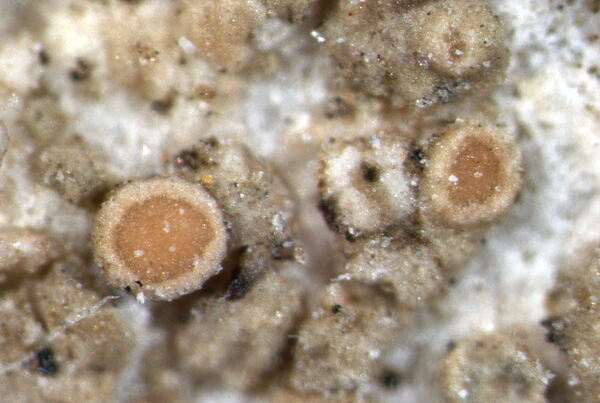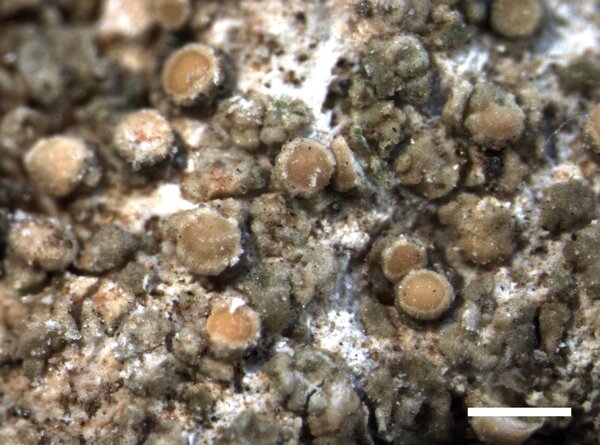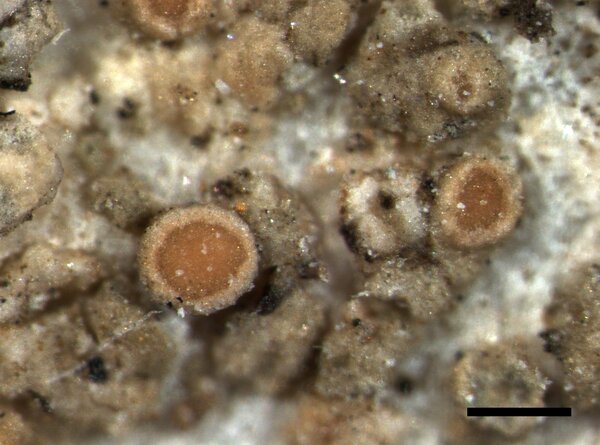Lecania olivacella (Nyl.) Zahlbr.
Cat. Lich. Univ., 5: 739, 1928. Basionym: Lecanora olivacella Nyl. - Flora, 58: 298, 1875.
Synonyms: Lecanora subalbens Nyl.
Distribution: N - Piem (TSB 32902), Lig (Valcuvia & al. 2000). C - Sar. S - Si (Nimis & al. 1996b).
Description: Thallus crustose, episubstratic, areolate-subsquamulose, white-grey to yellowish brown, forming up to 2(-3) cm wide patches, the areoles scattered, almost squamulose, 0.4-0.8 mm wide. Apothecia lecanorine, 0.3-0.4(-0.7) mm across, sessile, circular or ellipsoid, with an orange-red to dark brown (uniformly cinnamon-brown when wet), flat to slightly convex disc often surrounded by a darker parathecial ring, and a smooth to crenulate, narrow, whitish or whitish-grey, persistent thalline margin. Thalline exciple overlain by an epinecral layer, with a thin pseudoparenchymatous cortex of isodiametrical or oval cells and a medulla rich in algae; proper exciple narrow, dark-pigmented in upper part; epithecium brown to orange-brown, the pigment (in water) rapidly extending to the upper part of the hymenium, with an epipsamma; hymenium colourless, 55-65 μm high; paraphyses mostly simple, the apical cells slightly swollen and pigmented; hypothecium colourless. Asci 8-spored, with a K/I+ blue tholus and a central non-amyloid area, Bacidia-type. Ascospores 1-septate, hyaline, narrowly ellipsoid, (10-)11.5-14 x 4.5-6 μm, without a gelatinous perispore. Photobiont chlorococcoid. Spot tests: thallus and medulla K-, C-, KC-, P-, UV-. Chemistry: without lichen substances.Note: a widespread, but rare species found on basic or calciferous siliceous rocks, with a wide altitudinal range; to be looked for further in the Alps.
Growth form: Crustose
Substrata: rocks
Photobiont: green algae other than Trentepohlia
Reproductive strategy: mainly sexual
Commonnes-rarity: (info)
Alpine belt: absent
Subalpine belt: extremely rare
Oromediterranean belt: rare
Montane belt: rare
Submediterranean belt: very rare
Padanian area: absent
Humid submediterranean belt: very rare
Humid mediterranean belt: very rare
Dry mediterranean belt: absent

Predictive model
Herbarium samples
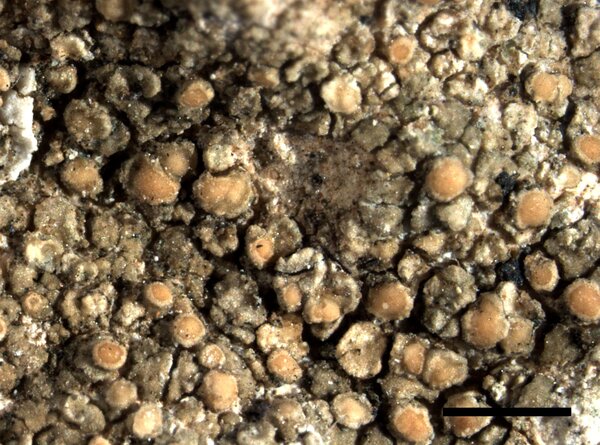

Elena Pittao; Owner: Department of Life Sciences, University of Trieste
Herbarium: TSB (20105)
15/02/2017
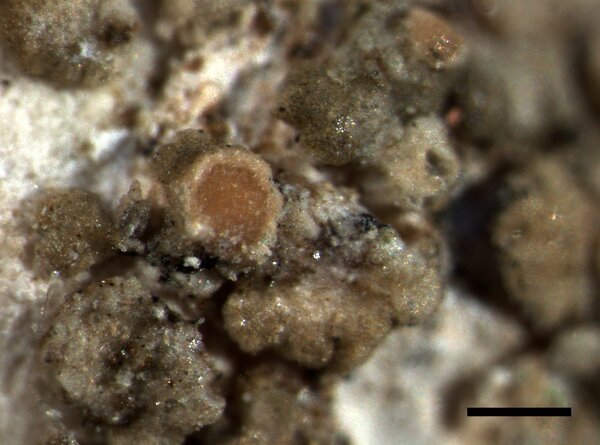

Elena Pittao; Owner: Department of Life Sciences, University of Trieste
Herbarium: TSB (20105)
15/02/2017
Growth form: Crustose
Substrata: rocks
Photobiont: green algae other than Trentepohlia
Reproductive strategy: mainly sexual
Commonnes-rarity: (info)
Alpine belt: absent
Subalpine belt: extremely rare
Oromediterranean belt: rare
Montane belt: rare
Submediterranean belt: very rare
Padanian area: absent
Humid submediterranean belt: very rare
Humid mediterranean belt: very rare
Dry mediterranean belt: absent

Predictive model
| Herbarium samples |


Elena Pittao; Owner: Department of Life Sciences, University of Trieste
Herbarium: TSB (20105)
15/02/2017


 INDEX FUNGORUM
INDEX FUNGORUM
 GBIF
GBIF
